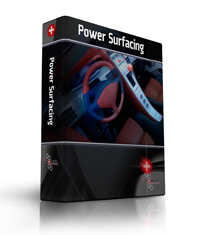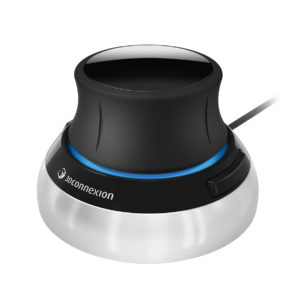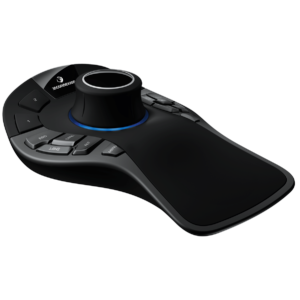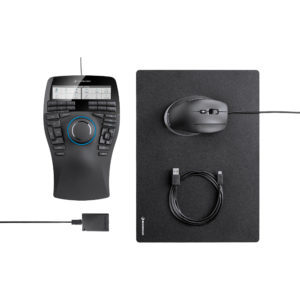Product Description

- Do you struggle to create freeform/organic shapes with SOLIDWORKS®?
- Do you avoid making changes to surface features because it is too time consuming?
- Do you have difficulty creating aesthetically pleasing Class A surfaces with tangent and curvature continuity?
- Are you forced to utilize software other than SOLIDWORKS® for designing organic shaped components?
- Do you need to import polygonal objects created outside of SOLIDWORKS®?
We have an answer that may work for you! Power Surfacing is a revolutionary SOLIDWORKS® plugin product that will fundamentally change the way that engineers and designers design parts in SOLIDWORKS®. Power Surfacing makes it easy and fun to design complex free form aesthetically pleasing Class A surfaces in SOLIDWORKS®. No longer will you have to fight with patching a set of trimmed surfaces together to form complex curved shapes; manipulating Power Surfacing parts is as simple as modeling with clay. With the release of Version 4.1 we have turned our Power Body objects into macro features so that they behave more like typical SOLIDWORKS® features, and they can be created and edited directly from SOLIDWORKS® assemblies. And you can now easily use Power Surfacing bodies as instances or references.
*A fully integrated SOLIDWORKS toolkit that introduces SubD modeling to complement existing NURBS creation features. Version 8.0 supports SW 2023 and is our latest version.
For all of the same great features plus the power of reverse engineering, check out nPower’s Power Surfacing RE for SOLIDWORKS.

Specs

Image for Power Surfacing
New in Version 4.1
The 4.1 release is a major upgrade for Power Surfacing. It includes the features most requested by customers, and it greatly improves productivity and usability. Although Power Surfacing was already tightly integrated with SOLIDWORKS®, this 4.1 version makes it even more seamless and easy to use. Power Surfacing was already the best tool for organic / free form surface modeling in SOLIDWORKS®, but it is now even more powerful, productive, and easy to use. Here are some of the new features that will greatly improve your productivity.
- Assemblies: full support for creation / editing in assembly mode
- Macro feature: automatic updating / multi-body Power Bodies
- Conversion options: automatic trim & sew / large mesh support
- Surface creation workflow: new paradigm for creating SubDs
Features
Assemblies
Power Surfacing now fully supports the SolidWorks Assembly modeling environment. You can now create and edit Power Surfacing features while in an assembly. It is even possible to import reference constraints from other parts in the assembly.
Macro Feature
Power Surfacing bodies are now macro features, which means they will behave like a typical SolidWorks features. You can also create multiple Power Surface bodies in a single part. Power Surfacing bodies will now automatically update as “standard” features in the feature tree do. When a Power Surface body in the feature tree is updated, it will automatically trim and sew the result (and make it into a sold body if it is solid). This automated process greatly improves the ability to update Power Surface bodies during edit and replay and thus facilitates a more reliable editing process.
Conversion options
We are introducing advanced control over the process for converting Power Surface geometry into SolidWorks bodies. In addition to the typical subdivision levels, you can also increase the level of refinement, control the quality / accuracy, etc. We have added a manual conversion option to explicitly control the number of subdivisions and refinements for the conversion process. For extremely large meshes (like ZBrush models), these numbers can be set to 0 / 0.
New surface workflow
As a new method for creating geometry, you can now work in surface creation mode, extending and shaping surfaces on the fly. Also, we now support a workflow for creating geometry from sketches. This is useful especially for doing things like creating 3D text.
Additional new features
Significant improvement in SubD to NURBS conversion performance (especially when constraints are used)
Curvature continuous constraints (G2)
Offset constraints
Editing the mirror plane: give much greater control over the mirror plane
Copy Power Surface body on move: easily duplicate Power Bodies
Lock triad: locks orientation to make it easier to create and modify non-orthogonal geometry
Partial edge loop selection: ability to select start edge, direction edge, end edge to select loop subset
Stop at lamina corners: convenience tool for surface modeling workflow
Create multiple Power Surface bodies in single edit session: ability to create new primitives within a Power Body
Scale about multiple selected entities about their local center
Expand selected, with advanced options: can use edge angle and number rings to expand the selection (allows fast selection of flat areas)
Quad mesh selected area: Retopologize a selected area of the mesh while maintaining the essential shape of the mesh
Relax / smooth selected area: local averaging of mesh vertices to smooth the area
Edge chamfer
Normal direction push: move geometry in direction of face normals, or expand / shrink object
New icons (matches new SolidWorks 2017 icon standards)
Override tangency on edges: now works on edges as well as faces
Fill faces – automatically fill in an area with a quad mesh
Curved selected improvement: intelligently smoothes selected faces while preserving overall shape
Draw on plane: create mesh geometry by drawing on a plane
Draw on multiple planes: create mesh geometry drawing on multiples planes
Create from sketch: create solid primitive utilizing SolidWorks sketch
Thicken with constraints: enhanced Thicken command to utilize face constraints
SubD checker: checks mesh validity
UI spinners
New, reorganized constraint menu
Closed periodic surfaces: can now create closed periodic surfaces on conversion
Offset constraints: constrain to an offset from a surface
G2 constraints: G2 curvature continuity on constraints
Benefits
Neither Sub-D (Subdivision Surface) modeling nor NURBS modeling can effectively solve all 3-D design problems. Each has strengths and weaknesses. Sub-D modeling is great at producing and modifying complex freeform / organic shapes with smooth surfaces. NURBS modeling is good at combining shapes via. Boolean and Feature operations as well as refining shapes with operations like filleting, blending and face editing. We really see Power Surfacing as a novel and powerful unification piece between these two technologies. Being able to use both modeling paradigms together in the modeling process provides huge productivity advantages in both the design and revision process. With the ability to connect Power Surface Sub-D objects directly to existing SOLIDWORKS® objects and to update the Sub-D to correspond to history tree modifications. Power Surfacing essentially provides dimension driven Sub-D modeling. Power Surfacing freeform design combined with SOLIDWORKS® parametric design provides SOLIDWORKS® users with a ground breaking Industrial Design toolkit.
Some of the industries supported by Power Surfacing include:
- Industrial Design
- Ergonomics
- Sporting goods & clothing
- Toys
- Character design
- Powertools and other handheld devices
- Jewelry
- Cutlery
- Furniture
- Automotive
- Art
- Packaging
- Robotics







